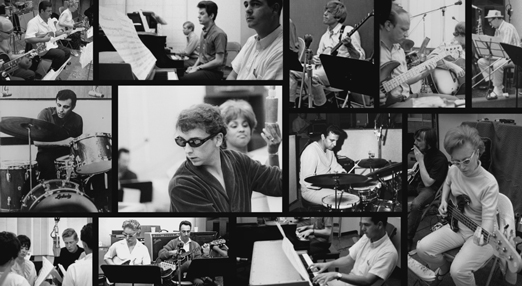
Growing up in the ’60s, in the era of Phil Spector and the Wall of Sound, The Beachboys, The Beatles — and all the groups who were a part of The British Invasion — was to feel vibrant and alive, hopeful for a better world for all, within a revolutionary era of societal change that spanned the globe.
Music served to awaken a younger generation to the possibility of change, to define an era for themselves, and be moved to work collectively for the betterment of society. And as anarchist Emma Goldman was wont to say, “If I can’t dance, I don’t want to be part of your revolution.” There was no music better to dance to than the music of Phil Spector’s Wall of Sound.
An excerpt from Danny Tedesco’s very fine 2008 documentary, The Wrecking Crew, in which Cher, American record producer and recording engineer, Bones Howe, bassist Carol Kaye, drummers Hal Blaine, and more, exclaim about Phil Spector and the Wall of Sound.
To attain the Wall of Sound, Spector’s arrangements called for large ensembles (including some instruments not generally used for ensemble playing, such as electric and acoustic guitars), with multiple instruments doubling or tripling many of the parts to create a fuller, richer tone.
For example, Spector would often duplicate a part played by an acoustic piano with an electric piano and a harpsichord. Mixed well enough, the three instruments would then be indistinguishable to the listener.
Additionally, Spector incorporated an array of orchestral instruments (strings, woodwind, brass and percussion) not previously associated with youth-oriented pop music. Reverb from an echo chamber was highlighted for additional texture, which he characterized as “a Wagnerian approach to rock & roll: little symphonies for the kids”. The intricacies of the technique were unprecedented in the field of sound production for popular music
Imagine being 12 years old, turning on the radio and hearing Darlene Love and The Crystals, The Ronettes, Smoky Robinson and The Miracles, The Beatles, Marvin Gaye, The Zombies, The Righteous Brothers, The Kinks, The Beach Boys, Diana Ross and The Supremes, Mary Wells, The Drifters, Chris Montez, Dionne Warwick, Martha and the Vandellas, Otis Redding, Roy Orbison, Ray Charles, and more, so much more — in the early ’60s, the hits really did ‘keep on comin‘, Vancouver’s CKLG part of the musical revolution.
Today on VanRamblings, a musical tribute to Phil Spector’s Wall of Sound, which in an era of one track studios embodied a revolutionary approach to the recording of music, setting a standard that prevails to this day, in the complex arrangements of your very favourite progressive bands and artists.
